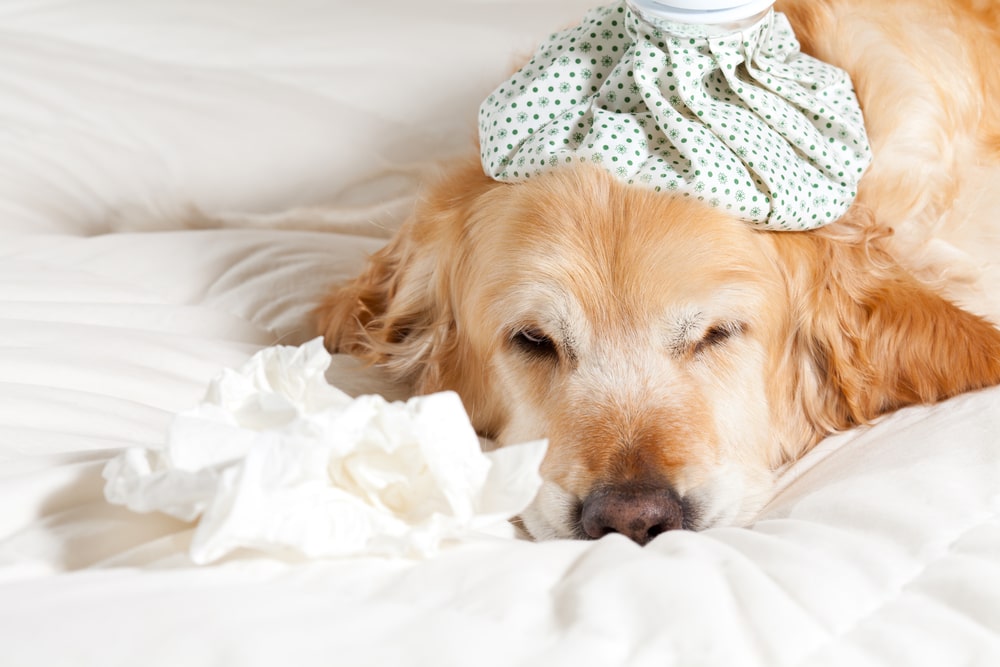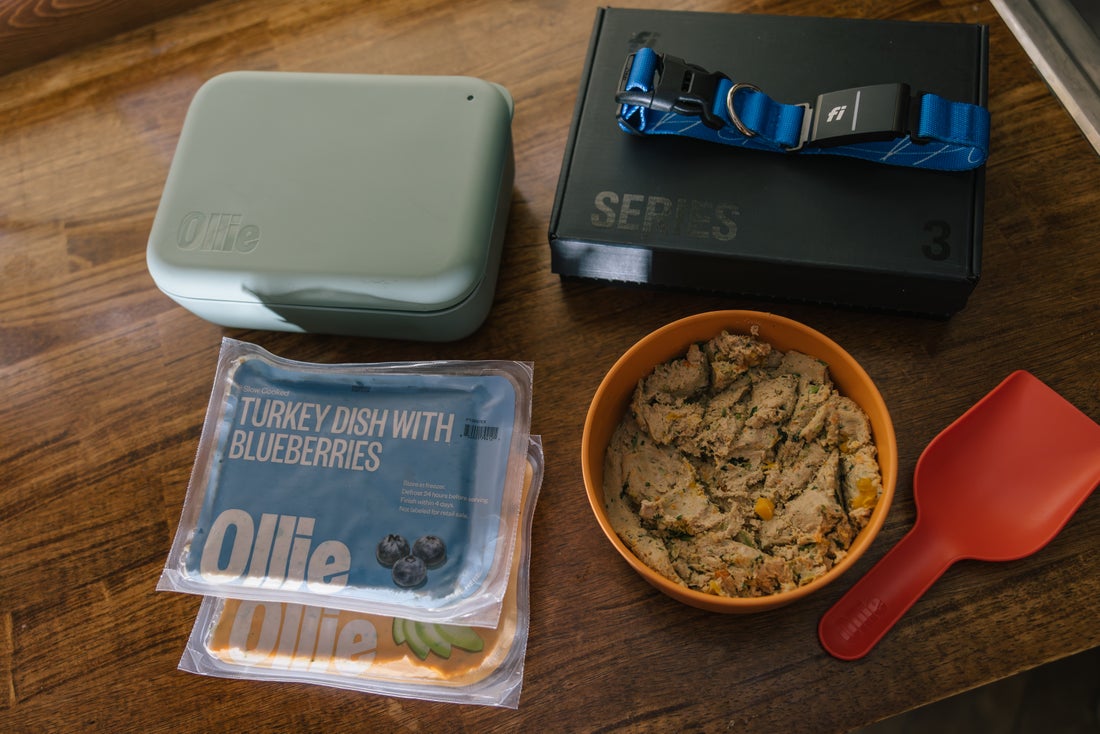Hey Ollie blog readers! We’re offering you an exclusive 60% OFF your starter box! Try now!
Most of us know the pain of strep throat, that raw, burning sensation that makes swallowing miserable. But what about your pup? Can dogs get strep throat too? While dogs can’t catch the exact same strain of strep that spreads through human schools and offices, they can develop infections caused by streptococcus bacteria. Some of these infections can affect the throat, tonsils, or even internal organs.
In this article, we’ll break down what you need to know about streptococcus in dogs, how it spreads, what symptoms to watch for, and when to call your vet.

Can dogs get strep throat?
The answer to this question is yes and no. According to Dr. Ernst Ward of VCA Hospitals , dogs don’t get strep throat. However, that isn’t the whole story. He says, “Although they do not get “strep throat,” they may harbor the bacterium and serve as a source of infection for humans.”
Therefore if your dog has the bacteria in his system it can be passed to you and any other humans who come into contact and should be treated with antibiotics.
Can Dogs Get Strep Throat From Humans?
The short answer: it’s extremely rare, but not impossible.
Streptococcus pyogenes, the bacteria responsible for strep throat in humans—is primarily a human-specific pathogen. According to the American Veterinary Medical Association (AVMA), dogs are not natural hosts for this strain, which means they don’t easily catch it from people.
However, in very rare cases, close contact with an infected person—like kissing, sharing food, or sleeping in the same bed—could expose a dog to the bacteria. Most dogs won’t develop classic symptoms of strep throat, but they could briefly harbor the bacteria without showing signs.
If someone in your household has strep throat, it’s best to avoid face-to-face contact with your pup until the infection has cleared.
Can I Get Strep Throat From My Dog?
Yes, it is possible to get strep throat from a dog, but it’s uncommon.
Dogs can carry streptococcus bacteria, especially if they’ve been exposed to a human with strep or are fighting an unrelated infection. While dogs don’t usually get strep throat themselves, they may act as silent carriers of the bacteria.
If your dog is carrying strep, they could transfer it through:
- Saliva (licking your face or mouth)
- Contaminated food bowls or toys
- Sneezing or coughing in close quarters
Important: If you or someone in your home has recurring strep infections, your vet may recommend testing your dog as a possible carrier. A short course of antibiotics can often resolve the issue.
Symptoms of Strep Throat in Dogs
Dogs don’t get strep throat the same way humans do, but they can develop streptococcal infections that affect their throat, tonsils, or respiratory system.
Here are common symptoms that may signal a strep-related illness in dogs:
- Coughing or hacking
- Difficulty swallowing
- Red or inflamed tonsils
- Lack of appetite
- Low energy or lethargy
- Mild fever
- Pawing at the mouth or jaw
If your dog shows these signs, especially if someone in the household recently had strep, it’s worth getting them checked out. A vet can swab the throat or perform tests to identify the bacteria.
How To Prevent Streptococcus In Dogs
While strep infections in dogs are rare, there are a few simple steps you can take to reduce the risk of exposure and protect your pup’s immune system.
1. Practice Good Hygiene
Wash your hands before and after handling your dog, especially if someone in your home is sick. Avoid letting your dog lick your face or share utensils or cups.
2. Limit Contact During Illness
If you have strep throat, try to limit close interactions with your dog until you’ve been on antibiotics for at least 24 hours.
3. Feed a High-Quality Diet
A strong immune system starts with good nutrition. Feeding a fresh, balanced diet like Ollie can help your dog’s body fight off infections more effectively.
4. Stay Up-to-Date on Vet Visits
Regular checkups help catch issues early. If your vet suspects a bacterial infection, they may prescribe antibiotics to clear it before it spreads or worsens.
How to know if your dog is carrying the bacteria that causes strep throat?
Your vet will need to do a culture to confirm that your pet is carrying the bacteria. In the meantime, there are some symptoms of sore throat or tonsillitis that you may see before you even take your pet to the doctor. These include:

- Coughing: Your dog may cough due to the irritation in its throat
- Lip licking: This is another sign of discomfort
- No desire to eat and drink: Due to the pain of swallowing with inflamed tonsils, your pet may appear hungry but still not eat or drink.
- Gagging: Your dog might feel like something is stuck in its throat
- Low energy: Fghting infection takes a lot of energy so your dog may not be his usual playful self. Your dog may sleep more and you could see a dullness in his eyes while he isn’t feeling so good.
It is very rare for a dog to have its tonsils removed even if they are prone to infection. This is because your dog will need its tonsils to help fight future infections.
How to treat strep in your dog
Make sure your pet is well hydrated and is getting plenty of rest. Your vet will need to prescribe some antibiotics to clear up the bacteria. The vet may also give you an anti-inflammatory medicine to help with the pain!
If you have multiple dogs in your home, you’ll want to quarantine any sick pets so you don’t risk spreading germs. Humans should be extra diligent about hand-washing after interacting with a sick dog to avoid further spread of germs.

Once the dog has started the antibiotics they should be better within a few days. Ask your vet about the duration of antibiotic use and be sure to follow the directions. Your pet needs to take all of the antibiotics even if he is feeling better.
Monitor your pet for allergies to the antibiotics and follow up with your vet if you notice any side effects or your pet continues to not feel well.
You may wish to have your dog re-cultured after treatment to ensure the infection is gone. Strep is highly contagious and can be passed back and forth between dogs and humans. If members of your family continue to have symptoms your dog may be the carrier. If you or a member of your family falls ill, you’ll want to make sure that you’re all treated as well as strep can be serious in humans too!

The anatomy of a dog’s throat and tonsils
Like you, your dog has a pair of tonsils at the back of its throat. The tonsils are similar to lymph nodes, and the role of both of these structures is to fight infection. They sit in small pouches called crypts at the back of your dog’s throat.
When the dog is fighting an infection, the tonsils may enlarge due to inflammation. Infected tonsils will be swollen and red and can be seen easily at the back of your dog’s throat.
If your pet is showing signs of illness, the vet will examine your dog’s throat to check for inflammation in the tonsils.
Another reason that the tonsils sometimes get inflamed is due to tartar buildup and periodontal disease. If this is the cause of your pet’s tonsil inflammation, your vet will need to give your dog’s teeth a good cleaning. To perform this procedure, your dog will need to undergo general anesthesia. You can discuss the risks of this with your vet before the procedure, especially if you have an older pet.
Frequently Asked Questions About Strep Throat in Dogs
Can dogs get strep throat like humans?
Not exactly. Dogs don’t typically get the same kind of strep throat that humans do. However, they can carry streptococcus bacteria, which may lead to other types of infections—such as tonsillitis, respiratory issues, or skin infections.
Can I catch strep throat from my dog?
Yes, but it’s rare. If your dog is carrying Streptococcus pyogenes, they can potentially pass it to humans through close contact, like licking or sneezing. This is more likely if someone in your household has had recurring strep infections.
How do dogs get streptococcus?
Dogs can be exposed to streptococcus bacteria through close contact with infected humans, other dogs, or contaminated surfaces. Poor hygiene, weakened immune systems, or other illnesses may increase their risk of developing an infection.
What are the signs of strep infection in dogs?
Dogs with streptococcus-related illness may show symptoms such as:
- Coughing
- Swollen tonsils
- Difficulty swallowing
- Low energy
- Loss of appetite
- Fever
If you notice these signs, contact your vet for an evaluation and possible throat swab.
Is strep throat in dogs contagious to other pets?
Most types of streptococcus infections in dogs are not highly contagious, but it depends on the strain. If your dog is diagnosed, your vet may recommend keeping them isolated and cleaning shared surfaces, bowls, and toys.
How is strep treated in dogs?
Treatment usually involves a course of veterinary-prescribed antibiotics. Your vet may also recommend supportive care like hydration, rest, and soft foods if your dog has trouble swallowing.
Can feeding my dog better food help prevent infections?
Yes. Feeding your dog a balanced, nutrient-rich diet like Ollie supports a strong immune system, which can help reduce their risk of bacterial infections—strep included.
The Ollie blog is devoted to helping pet parents lead healthier lives with their pups. If you want to learn more about our fresh, human-grade food, check out MyOllie.com.
Tagged As:

The nutrition your dog needs,
the food they want.

Enjoying our articles? Subscribe our Newsletters and get new articles directly to your inbox
You might also like
9 October 2025
4 MINS READ
How Fresh Food Can Help Soothe Your Dog’s Allergies
As a pup parent, watching your dog suffer from the constant discomfort of allergies is always distressing. The endless scratching, irritated skin, and digestive upset can take a toll on your pup�…
by Ollie Pets
18 September 2025
4 MINS READ
Is Fresh Dog Food Easier to Digest?
Yes, fresh dog food is generally easier for dogs to digest than highly processed kibble. Because it’s made with whole ingredients, gently cooked, and free from unnecessary fillers, fresh food supp…
by Ollie Pets
18 September 2025
5 MINS READ
Can I Rotate Fresh Dog Food Flavors?
Yes, it’s safe to rotate fresh dog food flavors, and many dogs actually benefit from the variety. At Ollie, we offer multiple fresh recipes, like Beef, Chicken, Turkey, Lamb, and Pork so you can…
by Ollie Pets







